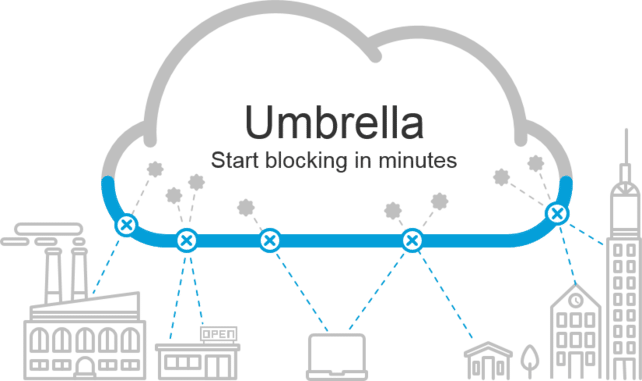
For businesses looking to increase their cybersecurity posture, one option (among the many they should be implementing) is DNS security.
This type of cyber protection is one of the pieces of armor you should implement along with firewalls, next-generation antivirus, anti-spam, etc.
When it comes to implementing DNS security, at The KR Group, our security team uses Cisco Umbrella in our Purple Team Hive Assessments. As a Cisco partner, we also sell it to businesses looking to enhance their security posture.
Cisco offers Cisco Umbrella for DNS security, and it has many other IT security features, including website blocking, ransomware detection, content filtering.
We think there are many benefits to DNS security, specifically with Cisco Umbrella. But, before we get to the benefits, we’ll explain what DNS security is and how it works.
DNS Security Definition
To understand DNS security, first, we need to explain what DNS is.
DNS, which stands for domain name system translates domain names into IP addresses. This process, a DNS query, makes web surfing simpler for humans since it’s easier to memorize a name than a set of numbers (IP addresses).
Behind the scenes, DNS servers process the request so the user is seamlessly directed to the website they’re trying to access.
However, DNS queries create opportunities for exploits, and not all domains are safe. DNS security tools identify unsafe domains and then alert and prevent users from accessing suspected hijacked or malicious domains.
For example, if a user clicks on a malicious link in a phishing email, DNS security should identify and stop the request.
Cisco Umbrella is one solution for DNS security, but it’s earned our recognition for its performance and a relatively large set of features.
So why do we recommend and use it? Besides being a necessary component of your IT environment for DNS protection, Umbrella users have the advantage of benefitting from four other features:
- Cisco Umbrella with agents provide granular visibility.
- Cisco Umbrella acts as a content filter.
- Cisco Umbrella is easy to deploy.
- Cisco Umbrella allows you to analyze threats in real-time.
All of these features make Cisco Umbrella a top-tier solution for protecting your network from malicious activity.
Deploy Cisco Umbrella with agents
DNS filtration systems are an effective way to identify and stop malicious attacks. However, you’ll still need to find the source of the attack to investigate the problem and warn other users.
With traditional DNS filters, you’d have to use a Public IP address and then track down the source, which can be time-consuming and tedious. However, with Cisco Umbrella, you have the option to deploy the DNS filter with agents (Umbrella Roaming Client) and simplify the process.
The agents reside on endpoints and identify the source of the malicious traffic. Since they’re tied to an endpoint, such as a desktop or laptop, if a user takes their laptop home with them or on a trip, the agent still monitors and reports any anomalous activity.
Threats are limited to entering your system through in-office devices. Being able to detect malicious activity from users’ devices outside of your physical office allows you to better protect your network and then identify the source.
Use Cisco Umbrella as a content filter
Cisco Umbrella wasn’t specifically designed as a content filter.
However, since it works by monitoring DNS queries, you’re able to use it as one, and it does a good job at it.
To repeat, Cisco Umbrella works as a DNS filter by identifying malicious or suspected malicious domains. This capability can be configured to prevent users from accessing other domains, even if they aren’t malicious.
You can choose different categories to block, such as public proxies, sites known for torrent downloads, sites with explicit content, and other specific requests.
Along with preventing users from accessing malicious or likely malicious sites, using DNS filtration this way restricts your users from accessing sites you don’t want them using on company devices or during business hours.
Easily deploy Cisco Umbrella

One of our favorite features of Cisco Umbrella is, even with its many capabilities, it is still relatively simple to configure and deploy.
Implementing your new DNS filter into your network should be done sooner rather than later so you can start to reap the benefits of protection.
While it does take time to set up some of the more specific configurations you can immediately set up the basic features, including DNS and content filtering.
Essentially, you or your Cisco partner can set up the framework of Umbrella so it’s working in your environment and you’re protected while you schedule a time to delve deeper into what specific features you want.
Real-time threat analysis with Cisco Umbrella
Cisco Umbrella is proactive in how it identifies and stops malicious command-and-control (C2) callbacks, and it also allows a way to review identified threats.
You can set up Umbrella to send notifications to administrators when users access content or make requests that they shouldn’t or when a suspected attack is identified.
Umbrella’s threat analysis features don’t allow you to monitor the internal actions of your users, though. However, you can view a log of blocked content and requests.
Why should you use Cisco Umbrella?
When it comes to identifying and stopping suspicious and malicious activity within your network, Cisco Umbrella goes above and beyond.
When it comes to functioning as a DNS filter, Umbrella gets the job done. However, in addition to its main function, we use and recommend Cisco Umbrella for some of its other features, including agent reporting, content filtering, easy deployment, and real-time threat analysis.
If you’re looking to enhance your security posture with a DNS filter, Cisco Umbrella goes above and beyond.
For more information on this solution, download our free FAQs sheet.


